It looks like you're using an Ad Blocker.
Please white-list or disable AboveTopSecret.com in your ad-blocking tool.
Thank you.
Some features of ATS will be disabled while you continue to use an ad-blocker.
share:
reply to post by beansidhe
Kind of reminds me of the fajada butte symbols...
I know it's not the same but you might want to compare you symbols with A Field Guide to Rock Art Symbols of the Greater Southwest. it looks to my like there could be some overlap?
Book can be viewed here
Kind of reminds me of the fajada butte symbols...
I know it's not the same but you might want to compare you symbols with A Field Guide to Rock Art Symbols of the Greater Southwest. it looks to my like there could be some overlap?
Book can be viewed here
"I think the Pictish Beastie is a seahorse. That is what it looks like. Not a dolphin or anything else, but a seahorse."
reply to post by OpinionatedB
I have always seen it as a Kelpie. It may be something else, but I doubt it is a dolphin. It has a tail like a horse and no fin.
Another thing, which may be signiicant, is that I have noticed the stylised depiction of the "beastie" rarely changes regardless of the style of artwork, or era, the surrounding carvings were done in. In other words, the "beastie" had to be done in a specific way each time. Which means that particular depiction had some sort of relevance and significance to the Picts and also to us.
As mentioned before the z-rod looks like a broken arrow/spears. Does this signify "a place of conflict", a place of "no conflict", such as a place of alliance, a place of peace?
PS...thanks for the replies (banshee, ektar et al). I can't get on here all the time, but I do keep tabs on whats going down here
reply to post by OpinionatedB
I have always seen it as a Kelpie. It may be something else, but I doubt it is a dolphin. It has a tail like a horse and no fin.
Another thing, which may be signiicant, is that I have noticed the stylised depiction of the "beastie" rarely changes regardless of the style of artwork, or era, the surrounding carvings were done in. In other words, the "beastie" had to be done in a specific way each time. Which means that particular depiction had some sort of relevance and significance to the Picts and also to us.
As mentioned before the z-rod looks like a broken arrow/spears. Does this signify "a place of conflict", a place of "no conflict", such as a place of alliance, a place of peace?
PS...thanks for the replies (banshee, ektar et al). I can't get on here all the time, but I do keep tabs on whats going down here
edit on
18-2-2014 by AtroxLux because: Doh!
reply to post by HardCorps
Thanks HardCorps, there's those spirals again!
What the author says about the spirals is fascinating. They can represent the time between migrations, the direction the people travelled (well spotted, OpinionatedB), how many times they left, the 'journey to Centre', a whirlwind and the myths behind the bringer of the whirlwind, a method of spiral planting....and more! Depending on their context, and who was using them; without knowing that it would be almost impossible to guess correctly.
You've come along at just the right time to remind me how many layers might be present in the symbols.
If there was an indigenous population, who had begun to make the earliest recorded astronomical calendars with standing stones (Stones of Stenness) around five and a half thousand years ago, they would have had long standing traditions and a culture uniquely their own by the time the Phoenicians arrived, having integrated with other travellers through the centuries too.
But the Phoenician influence cannot really be denied either, which is why I'm hunting for clues there too.
Thanks HardCorps!
Thanks HardCorps, there's those spirals again!
What the author says about the spirals is fascinating. They can represent the time between migrations, the direction the people travelled (well spotted, OpinionatedB), how many times they left, the 'journey to Centre', a whirlwind and the myths behind the bringer of the whirlwind, a method of spiral planting....and more! Depending on their context, and who was using them; without knowing that it would be almost impossible to guess correctly.
You've come along at just the right time to remind me how many layers might be present in the symbols.
If there was an indigenous population, who had begun to make the earliest recorded astronomical calendars with standing stones (Stones of Stenness) around five and a half thousand years ago, they would have had long standing traditions and a culture uniquely their own by the time the Phoenicians arrived, having integrated with other travellers through the centuries too.
But the Phoenician influence cannot really be denied either, which is why I'm hunting for clues there too.
Thanks HardCorps!
reply to post by beansidhe
Hi Beansidhe,
It's good to see minoans getting some attention,
It was the minoans who set the stage for the phonecians. Everywhere the phonecians went the minoans were there a thousand years earlier.
The city state of phonecia grew from a Minoan/akkadian trade center.
The Mesopotamian influence mentioned earlier was via the minoans, as well as the Egyptian influences.
The Patagonian monster s blog is very good
Hi Beansidhe,
It's good to see minoans getting some attention,
It was the minoans who set the stage for the phonecians. Everywhere the phonecians went the minoans were there a thousand years earlier.
The city state of phonecia grew from a Minoan/akkadian trade center.
The Mesopotamian influence mentioned earlier was via the minoans, as well as the Egyptian influences.
The Patagonian monster s blog is very good
reply to post by punkinworks10
Hi punkinworks!
I really like that blog, I've just found it! I like his writing style a lot - he just wonders and speculates, he doesn't claim to be some kind of expert, although he's clearly a very clever, educated man.
So the Minoans aren't too far back to have influenced the Pict stones via the Phoenicians? I thought I might be stretching it a bit with the shield, so good to hear that from you. There definitely seems to be influence from that region, and because the Pict stones are so unique, and aren't found anywhere else in Britain, the influence must have come from an outside source, albeit maybe earlier than supposed. Otherwise they would look more 'celtic'. Now I just need to learn to read Phoenician, and I'll be sorted!!
Hi punkinworks!
I really like that blog, I've just found it! I like his writing style a lot - he just wonders and speculates, he doesn't claim to be some kind of expert, although he's clearly a very clever, educated man.
So the Minoans aren't too far back to have influenced the Pict stones via the Phoenicians? I thought I might be stretching it a bit with the shield, so good to hear that from you. There definitely seems to be influence from that region, and because the Pict stones are so unique, and aren't found anywhere else in Britain, the influence must have come from an outside source, albeit maybe earlier than supposed. Otherwise they would look more 'celtic'. Now I just need to learn to read Phoenician, and I'll be sorted!!
reply to post by beansidhe
Hi Beansidhe
Interesting about the T and thge earth. Hve you looked at the lastofthedruids.com site and its Pictish contents as its very interesting. It appears that the Picts had their own Zodiac and I suspect it may have been used to date certain events or ceremonies. Perhaps they carved references to these on the stones.
Fascinating post and especially how it appears to link to other people from around the world. I don't expect its easy for us to guess that easily athings about a culture that was so different in some aspects to ours today because with our technology and cement lined lives their world does not interconnect with much of our every day lives, especially if one lives in a town or city and is interested in nature or the past.
Hi Beansidhe
Interesting about the T and thge earth. Hve you looked at the lastofthedruids.com site and its Pictish contents as its very interesting. It appears that the Picts had their own Zodiac and I suspect it may have been used to date certain events or ceremonies. Perhaps they carved references to these on the stones.
Fascinating post and especially how it appears to link to other people from around the world. I don't expect its easy for us to guess that easily athings about a culture that was so different in some aspects to ours today because with our technology and cement lined lives their world does not interconnect with much of our every day lives, especially if one lives in a town or city and is interested in nature or the past.
reply to post by Shiloh7
Hey Shiloh!
You're right, it's important not to confuse what we would think of as important, with what they would find important, as our worlds have changed so much.
I'm going to check out that site right away, thanks!
Just back - that is good. And I'm going to borrow all his hard work for this thread because:
Last of the Druids
That is so exciting because those were animals that wouldn't 'fit' the constellation theory. Thanks Shiloh!
Hey Shiloh!
You're right, it's important not to confuse what we would think of as important, with what they would find important, as our worlds have changed so much.
I'm going to check out that site right away, thanks!
Just back - that is good. And I'm going to borrow all his hard work for this thread because:
There is also a fragment of fascinating evidence from a traditional German ’folk’ rhyme. There is little information as to how old this poem is or anything else on its origins, but it apparently describes an alternative zodiac or at least a sequence of stars or constellations associated with the changing seasons:
‘Eber, Riese, Himmelskuh zählen wir dem Winter zu.
Hase, Wolf und Menschenpaar stellen uns den Frühling dar.
In Hahn und Hengst und Ährenfrau die Sommersonne steht genau.
Schwalbe, Hirsch und Bogenschütz sind des Herbstes feste Stütz.’
This has been translated into English as:
‘Boar, giant, and celestial cow we count to the winter.
Hare, wolf and human pair represent the spring.
At rooster, stallion and corn-ear-woman is summer solstice.
Swallow, deer (stag) and archer are the frame of autumn.’
From the above text, which is clearly referring to the night sky, only the human pair (Gemini), the corn-ear-woman (Virgo), and the archer (Sagittarius) are obviously discernible, although the celestial cow may represent Taurus. But noticeably within the sequence we have the appearance of a stag and a wild boar; the stag is associated with the autumn, as Scorpio is, whilst the boar is associated with the winter. In addition, the stag appears in the poem alongside the archer – remembering that Scorpio and Sagittarius are side by side in the Graeco-Roman Zodiac. This perhaps may hint at alternative northern European constellations including a stag and a wild boar; some of these may even be zodiacal.
Last of the Druids
That is so exciting because those were animals that wouldn't 'fit' the constellation theory. Thanks Shiloh!
edit on 18-2-2014 by
beansidhe because: Looked at website.
reply to post by beansidhe
There is a blog about the minoans and the influence they had, I'll try to find the original post.
In an earlier post you mentioned how complicated it is, the history of the British isles is very complicated.
First you have the neolithic hunter gathered who were displaced by later continental people , who were in turn displaced/replaced by the proto Celtic beaker folk, with their pottery and metal working. They were influenced by minoans ,Myceneans, phonecians, carthaginians. Then the Romans show up and bring a bunch eastern European horse men, then the jutes, angles and Saxons followed by the Danes and the Norse, and finally the French speaking Norse, the Normans.
There is a blog about the minoans and the influence they had, I'll try to find the original post.
In an earlier post you mentioned how complicated it is, the history of the British isles is very complicated.
First you have the neolithic hunter gathered who were displaced by later continental people , who were in turn displaced/replaced by the proto Celtic beaker folk, with their pottery and metal working. They were influenced by minoans ,Myceneans, phonecians, carthaginians. Then the Romans show up and bring a bunch eastern European horse men, then the jutes, angles and Saxons followed by the Danes and the Norse, and finally the French speaking Norse, the Normans.
Oops dble post,
edit on 18-2-2014 by punkinworks10 because: (no reason given)
I tend to lean more towards the astronomical aspects
in regards to the older stones due to how perfectly
the math seems to fit with explanations.
I see the Beastie as "Nessie", many surrounding that possibility
of course with a "wee bit" of bias...LOL!
That was alot of catching up I had to do. GREAT & fascinating stuff guys!
I like how everyone keeps finding ties to other groups way outside the Picts
that I never would have imagined.
I did not find any more information regarding the tuning fork...just tuning fork.
Cheers
Ektar
in regards to the older stones due to how perfectly
the math seems to fit with explanations.
I see the Beastie as "Nessie", many surrounding that possibility
of course with a "wee bit" of bias...LOL!
That was alot of catching up I had to do. GREAT & fascinating stuff guys!
I like how everyone keeps finding ties to other groups way outside the Picts
that I never would have imagined.
I did not find any more information regarding the tuning fork...just tuning fork.
Cheers
Ektar
reply to post by punkinworks10
Hmm. This might take a while then! If you could find that blog, it would be amazing.
Thanks punkinworks.
And a star for both posts, for being helpful!
Hmm. This might take a while then! If you could find that blog, it would be amazing.
Thanks punkinworks.
And a star for both posts, for being helpful!
reply to post by Ektar
The tuning fork is bizarre, I'm at a loss with that too, unless it is another blacksmith's tool, like AtroxLux said. I'm hoping it's a Minoan thing, and everything will fall into place!
But look what Shiloh brought - the gap in the constellation theory may be solved!
St Columba is meant to have met Nessie, so it's not a bad idea really - water monsters have a definite place in Scottish folklore.
It is amazing me how entwined everything is - I'm just grateful you're all so knowledgeable about such things!
The tuning fork is bizarre, I'm at a loss with that too, unless it is another blacksmith's tool, like AtroxLux said. I'm hoping it's a Minoan thing, and everything will fall into place!
But look what Shiloh brought - the gap in the constellation theory may be solved!
St Columba is meant to have met Nessie, so it's not a bad idea really - water monsters have a definite place in Scottish folklore.
It is amazing me how entwined everything is - I'm just grateful you're all so knowledgeable about such things!
Here you go Beansidhe,
www.minoanatlantis.com...
There is no reason for the Minoan explorers to have halted their endeavors in southeastern Iberia. Their new ships were certainly more capable of traveling in the ocean that the stitched boats that reached the Atlantic coast of Iberia during the Aegean (Cardial) Neolithic period. They would have simply continued to methodically scour the Atlantic coastlines and river valleys for evidence of metals to the north and south once they had passed through the "Pillars of Hercules". Notably, there is evidence from the analysis of alluvial sediments that the vast Rio Tinto copper, silver, and gold mines in southwestern Spain, north of Huelva on the Atlantic coast, began to be worked during the 3rd Millennia B.C. (Nocete 2005). The nearby, smaller Sao Domingos and Tharsis mines that are quite close to Rio Tinto may have also been discovered at this time. It is highly probable that the Rio Tinto ores were originally mined by the Millarens, but I know of no archaeological finds at the site. After 5,000 years of mining, the Rio Tinto area is one of the most cratered, destroyed, and polluted places on earth.
Apparently they found no metallic ores of interest south of the Pillars of Hercules along the northwestern African coast. But the sediments of the northern coastlines of western Europe would have yielded the alluvial evidence of abundant metal ores. They may have discovered the gold, silver, and tin in Brittany in northwestern France before making the discovery of gold, tin, and other metals in southwestern Britain and Wales. Even though the superior alloying properties of tin with copper were unknown at this time its availability should have noted by the explorers. Also, there were deposits of gold, silver, and copper in Ireland. The explorers may have discovered the Canary, Madeira, and Azore islands and traveled far beyond, but I know of no archaeological evidence to support this. How far the Minoan voyages of discovery went north from the Pillars of Hercules along the coastlines of Europe can only await future archaeological evidence.
www.minoanatlantis.com...
edit on 18-2-2014 by punkinworks10 because: (no reason given)
reply to post by punkinworks10
That's brilliant, thanks!
Wow, he speculates that the Minoans may have been trading tin with Britain as early as 2200 BC. That certainly gives plenty of time for their culture and artifacts to filter into Scottish life before the Picts carved their stones.
That's brilliant, thanks!
Wow, he speculates that the Minoans may have been trading tin with Britain as early as 2200 BC. That certainly gives plenty of time for their culture and artifacts to filter into Scottish life before the Picts carved their stones.
edit on 18-2-2014 by beansidhe because: Addendum
reply to post by beansidhe
I was very impressed by the blog, I would say it would have only been a few years after the Minoan conquest of the Iberian mines that meaningful trade started. I think the fact that britain was so far away saved the islands from the same conquest that befell Iberia.
The Egyptian jewelry would have likely been brought by minoans as would the "Mycenean" daggers found at Stonehenge.
The chatholic and bronze ages are one of my fave subjects.
I have become keenly interestd in the several bronze age collapses, 2350, 2190, 1628 and 11 something, were centered on periods climate downturn and social political upheaval.
As far as the imagery of some of the things discussed has it's roots in some of these periods.
I just finished Mike Baillie's "Exodus to Arthur", it's about the evidence for earth's encounters with comets. Baillie is an Irish dendocronologist, the worlds foremost, dendocronology is the study of tree rings to establish secure dates for periods or events.
Through his Irish oak chronology , the dating of various events has been pinned down.
After reading it's more evedent to me that certain motifs arise witnessing these close encounters .
I was very impressed by the blog, I would say it would have only been a few years after the Minoan conquest of the Iberian mines that meaningful trade started. I think the fact that britain was so far away saved the islands from the same conquest that befell Iberia.
The Egyptian jewelry would have likely been brought by minoans as would the "Mycenean" daggers found at Stonehenge.
The chatholic and bronze ages are one of my fave subjects.
I have become keenly interestd in the several bronze age collapses, 2350, 2190, 1628 and 11 something, were centered on periods climate downturn and social political upheaval.
As far as the imagery of some of the things discussed has it's roots in some of these periods.
I just finished Mike Baillie's "Exodus to Arthur", it's about the evidence for earth's encounters with comets. Baillie is an Irish dendocronologist, the worlds foremost, dendocronology is the study of tree rings to establish secure dates for periods or events.
Through his Irish oak chronology , the dating of various events has been pinned down.
After reading it's more evedent to me that certain motifs arise witnessing these close encounters .
reply to post by AtroxLux
The beastie never changes, it is always that peculiar shape and always sort of 'hovering', looking down. The other thing that never changes is the angles of the Z rod and V rod. So, yes, agreed, that must be of huge significance. If it is a Kelpie, would it show up as a bad omen, or a warning? I'm thinking about when it appears with people. On it's own, on the class 1 stones, could it be there as appeasement - don't appear to us, we acknowledge you, sort of thing?
If we see the Z rod as a motif from earlier Phoenician influence, symbolising weapon, then the Z could show that!!! It has been decorated to look 'metallic', like a spear or weapon.
That's a brilliant idea, AtroxLux! I think I need to compare some stones with Z rods through the discs, and some without. Which I will do as soon as I can!
In other words, the "beastie" had to be done in a specific way each time. Which means that particular depiction had some sort of relevance and significance to the Picts and also to us.
As mentioned before the z-rod looks like a broken arrow/spears. Does this signify "a place of conflict", a place of "no conflict", such as a place of alliance, a place of peace?
The beastie never changes, it is always that peculiar shape and always sort of 'hovering', looking down. The other thing that never changes is the angles of the Z rod and V rod. So, yes, agreed, that must be of huge significance. If it is a Kelpie, would it show up as a bad omen, or a warning? I'm thinking about when it appears with people. On it's own, on the class 1 stones, could it be there as appeasement - don't appear to us, we acknowledge you, sort of thing?
If we see the Z rod as a motif from earlier Phoenician influence, symbolising weapon, then the Z could show that!!! It has been decorated to look 'metallic', like a spear or weapon.
That's a brilliant idea, AtroxLux! I think I need to compare some stones with Z rods through the discs, and some without. Which I will do as soon as I can!
edit on 19-2-2014 by beansidhe because: Idiocy
reply to post by punkinworks10
I wonder if that's where spirals come from? I know it's not what you're saying, but people would have been used to cutting down trees and would have known about tree rings showing the age of a tree. Counting tree rings seems to come naturally to children. So I wonder if that's where the idea that spirals could show time came from? Just a thought!
I also wonder if some of the motifs were already ancient by the time the Picts carved them - thinking back to the Callandish stones and the ring of Brodgar etc. Like the V rod perhaps, which so many people have noted could have astronomical significance.
As far as the imagery of some of the things discussed has it's roots in some of these periods.
I just finished Mike Baillie's "Exodus to Arthur", it's about the evidence for earth's encounters with comets. Baillie is an Irish dendocronologist, the worlds foremost, dendocronology is the study of tree rings to establish secure dates for periods or events.
Through his Irish oak chronology , the dating of various events has been pinned down.
After reading it's more evedent to me that certain motifs arise witnessing these close encounters .
I wonder if that's where spirals come from? I know it's not what you're saying, but people would have been used to cutting down trees and would have known about tree rings showing the age of a tree. Counting tree rings seems to come naturally to children. So I wonder if that's where the idea that spirals could show time came from? Just a thought!
I also wonder if some of the motifs were already ancient by the time the Picts carved them - thinking back to the Callandish stones and the ring of Brodgar etc. Like the V rod perhaps, which so many people have noted could have astronomical significance.
3 examples of the double disc without a Z rod, and unless I made a mistake counting, there are only 6.

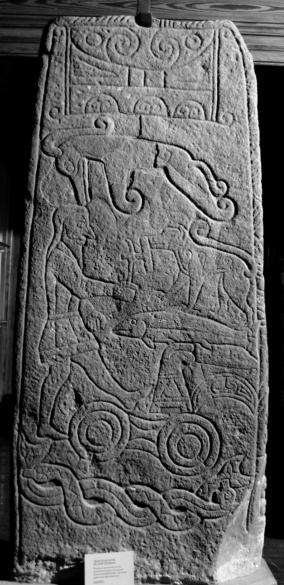
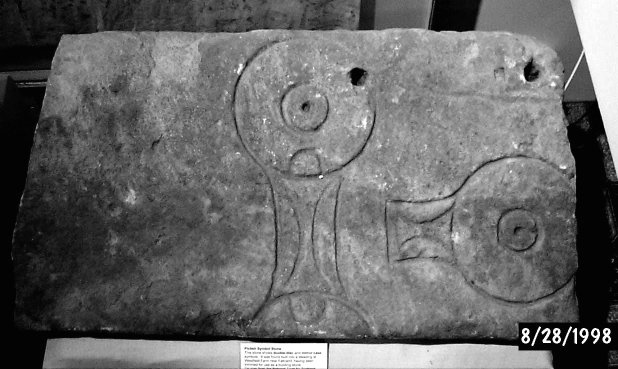
The first interesting thing, is that in the first two images, there are no V rods in the crescents, either. The second interesting thing is that in the third picture, the 'mirror' symbol is in fact half a disc. There goes my crappy shield theory!
The third interesting thing is that the middle stone (Meigle 6) is from much later, around 8 AD. And the beastie remains the same.



The first interesting thing, is that in the first two images, there are no V rods in the crescents, either. The second interesting thing is that in the third picture, the 'mirror' symbol is in fact half a disc. There goes my crappy shield theory!
The third interesting thing is that the middle stone (Meigle 6) is from much later, around 8 AD. And the beastie remains the same.
And three examples with the Z rod, of 78 found stones:
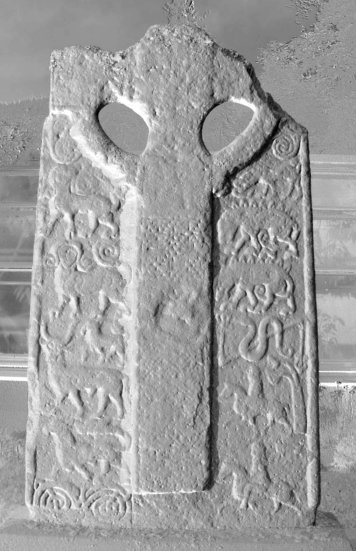
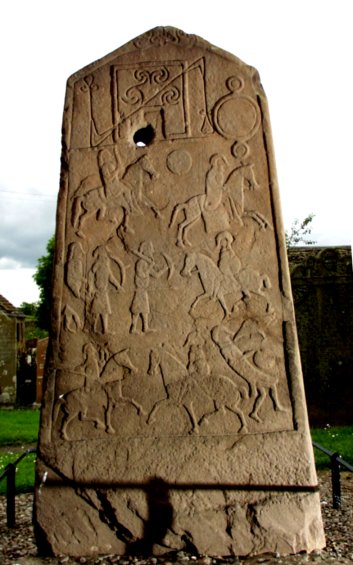
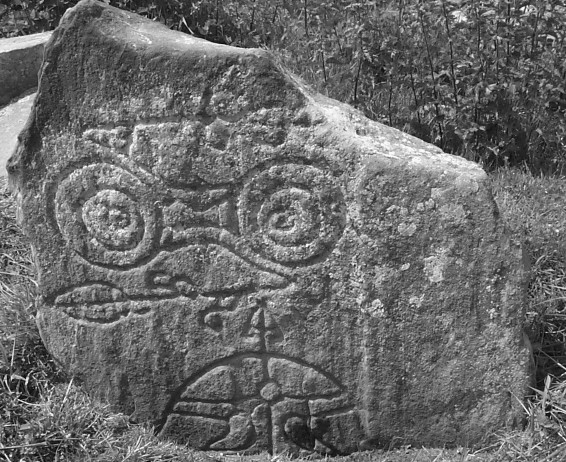
It's not found in a consistent place i.e.always at the top of a scene. And it features through discs, notched rectangles and snakes.
Interestingly it's shown on the only stone with a helmet, which might suggest it has definite links to battle.



It's not found in a consistent place i.e.always at the top of a scene. And it features through discs, notched rectangles and snakes.
Interestingly it's shown on the only stone with a helmet, which might suggest it has definite links to battle.
And on our 'Rosetta Stone' (sort of):
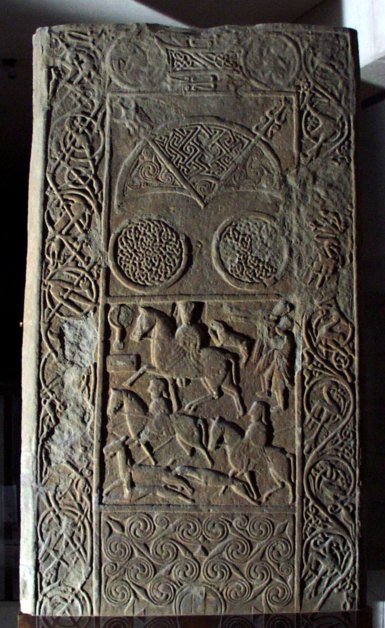
It's shown outside of the panels - maybe it's the 'title'? "There had been a battle." Or "It was a time of war."
If this is Guinevere/Cartimandau arriving, then the mirror and case shown together must signify her name.
The crescent and V rod is given equal prominence with the queen's arrival. In Shiloh's link, the writer was thinking in terms of auspices, certain symbols indicate good or bad times for events. If we already think that the crescent and V-rod symbolises astronomical knowledge, could this be a sign of an auspicious event? By this I mean, is it used on the stones to mark a fortunate occasion, much like we might send a good luck card with a shamrock on it? The symbol itself has many layers, but it's presence is specific (if you know what I mean).

It's shown outside of the panels - maybe it's the 'title'? "There had been a battle." Or "It was a time of war."
If this is Guinevere/Cartimandau arriving, then the mirror and case shown together must signify her name.
The crescent and V rod is given equal prominence with the queen's arrival. In Shiloh's link, the writer was thinking in terms of auspices, certain symbols indicate good or bad times for events. If we already think that the crescent and V-rod symbolises astronomical knowledge, could this be a sign of an auspicious event? By this I mean, is it used on the stones to mark a fortunate occasion, much like we might send a good luck card with a shamrock on it? The symbol itself has many layers, but it's presence is specific (if you know what I mean).
new topics
-
Rep. Alexandria O. Cortez Says Forcing People to Use The Correct Bathroom is Dangerous.
US Political Madness: 2 hours ago -
Cooperation zones
World War Three: 3 hours ago -
Ok this is some BS now WTH
Rant: 4 hours ago -
France gives Ukraine license to fire long-range missiles at Russia
World War Three: 7 hours ago -
Stalker 2 - Review from a Veteran
Video Games: 10 hours ago -
Does anyone have a link to download apple pay for androids
General Chit Chat: 11 hours ago -
Most INSANE internet rabbit hole
Secret Societies: 11 hours ago
top topics
-
Results of the use of the Oreshnik missile system in Dnepropetrovsk
World War Three: 17 hours ago, 14 flags -
France gives Ukraine license to fire long-range missiles at Russia
World War Three: 7 hours ago, 9 flags -
Most INSANE internet rabbit hole
Secret Societies: 11 hours ago, 8 flags -
Joe Rogan conspiracy (maybe)
ATS Skunk Works: 15 hours ago, 5 flags -
Ok this is some BS now WTH
Rant: 4 hours ago, 3 flags -
Stalker 2 - Review from a Veteran
Video Games: 10 hours ago, 2 flags -
Cooperation zones
World War Three: 3 hours ago, 2 flags -
Rep. Alexandria O. Cortez Says Forcing People to Use The Correct Bathroom is Dangerous.
US Political Madness: 2 hours ago, 2 flags -
Does anyone have a link to download apple pay for androids
General Chit Chat: 11 hours ago, 1 flags
active topics
-
Mood Music Part VI
Music • 3714 • : Hellmutt -
Cooperation zones
World War Three • 12 • : charlest2 -
Rep. Alexandria O. Cortez Says Forcing People to Use The Correct Bathroom is Dangerous.
US Political Madness • 15 • : BernnieJGato -
France gives Ukraine license to fire long-range missiles at Russia
World War Three • 12 • : WeMustCare -
-@TH3WH17ERABB17- -Q- ---TIME TO SHOW THE WORLD--- -Part- --44--
Dissecting Disinformation • 3364 • : 777Vader -
Inca stone masonry at Sacsayhuaman, Ollantaytambo and the Sun Temple
Ancient & Lost Civilizations • 15 • : randomtangentsrme -
Ok this is some BS now WTH
Rant • 5 • : BingoMcGoof -
Dr Cambell talking about using worm meds for cancer
Medical Issues & Conspiracies • 24 • : ADVISOR -
President-Elect TRUMP Picks Former Florida A.G. PAM BONDI to be U.S. Attorney General.
2024 Elections • 65 • : VariedcodeSole -
Well, here we go red lines crossed Biden gives the go ahead to use long range missiles
World War Three • 332 • : Tolkien
